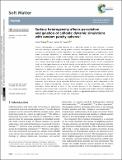| dc.contributor.author | Wang, Gang | |
| dc.contributor.author | Swan, James W. | |
| dc.contributor.author | Wang, Gang | |
| dc.date.accessioned | 2021-01-25T16:48:24Z | |
| dc.date.available | 2021-01-25T16:48:24Z | |
| dc.date.issued | 2019-06 | |
| dc.date.submitted | 2019-03 | |
| dc.identifier.issn | 1744-683X | |
| dc.identifier.issn | 1744-6848 | |
| dc.identifier.uri | https://hdl.handle.net/1721.1/129543 | |
| dc.description.abstract | Surface heterogeneity of colloidal particles has a significant impact on their structure in solution and their rheological properties. During particle synthesis, heterogeneous chemical functionalization, processes of self-assembly, or phase separation, can all lead to heterogeneous colloidal surfaces which impart anisotropic interactions to suspended particles. Additionally, an important class of colloids, biological macromolecules, exhibit similar localized, short-ranged, anisotropic interactions, which have a significant impact on their solution properties. Therefore, understanding the assembly and rheology of such colloids can provide insight into a wide variety of relevant physical systems. In this computational study, we investigate dispersions of particles having surface patches with randomized functionality as a model for heterogeneous colloids. We use Brownian dynamics simulations with hydrodynamic interactions to explore the differences between these random patchy particles and homogeneous (or isotropic) particles. The common basis used for comparing dispersions of particles with different surface functionality is equality of the second virial coefficient, so that dispersions of particles with different patterns of surface heterogeneity are similar thermodynamically at low particle concentrations. We show that at modest particle concentrations, significant deviations from the isotropic model are evident in the dispersion micro-structure, giving drastically different percolation transition points depending on the degree of surface heterogeneity. However, these deviations can be rationalized and a universal percolation criteria derived in terms of the osmotic pressure of the dispersion. Heterogeneous interactions also impose extra constraints on the relative translation and rotation between neighboring particles, which increase the viscosity and elastic modulus of aggregated dispersions and gels built from heterogeneous colloids and shifts the gel point measurably. | en_US |
| dc.description.sponsorship | NSF (Award 1554398) | en_US |
| dc.language.iso | en | |
| dc.publisher | Royal Society of Chemistry (RSC) | en_US |
| dc.relation.isversionof | http://dx.doi.org/10.1039/c9sm00607a | en_US |
| dc.rights | Creative Commons Attribution Noncommercial 3.0 unported license | en_US |
| dc.rights.uri | https://creativecommons.org/licenses/by-nc/3.0/ | en_US |
| dc.source | Royal Society of Chemistry (RSC) | en_US |
| dc.title | Surface heterogeneity affects percolation and gelation of colloids: dynamic simulations with random patchy spheres | en_US |
| dc.type | Article | en_US |
| dc.identifier.citation | Wang, Gang and James W. Swan. "Surface heterogeneity affects percolation and gelation of colloids: dynamic simulations with random patchy spheres." Soft Matter 15, 25 (June 2019): 5094-5108 © 2019 The Royal Society of Chemistry | en_US |
| dc.contributor.department | Massachusetts Institute of Technology. Department of Chemical Engineering | en_US |
| dc.relation.journal | Soft Matter | en_US |
| dc.eprint.version | Final published version | en_US |
| dc.type.uri | http://purl.org/eprint/type/JournalArticle | en_US |
| eprint.status | http://purl.org/eprint/status/PeerReviewed | en_US |
| dc.date.updated | 2019-07-18T12:40:58Z | |
| dspace.date.submission | 2019-07-18T12:41:00Z | |
| mit.journal.volume | 15 | en_US |
| mit.journal.issue | 25 | en_US |
| mit.metadata.status | Complete | |
